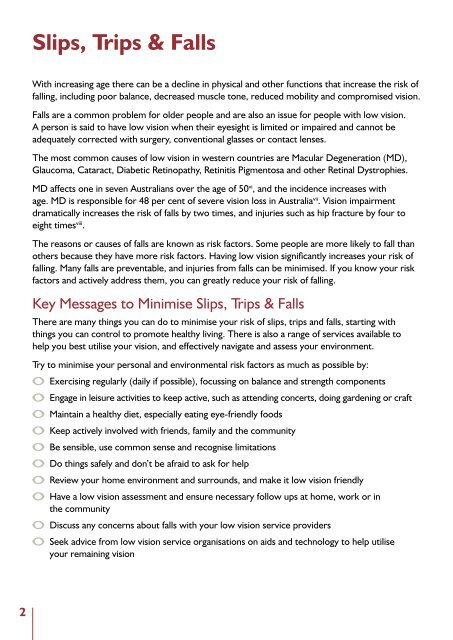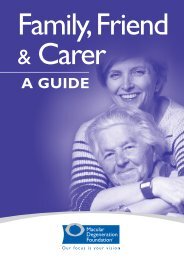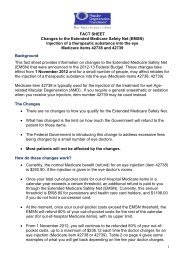Slips, Trips & Falls - A Guide
Slips, Trips & Falls - A Guide
Slips, Trips & Falls - A Guide
Create successful ePaper yourself
Turn your PDF publications into a flip-book with our unique Google optimized e-Paper software.
<strong>Slips</strong>, <strong>Trips</strong> & <strong>Falls</strong><br />
With increasing age there can be a decline in physical and other functions that increase the risk of<br />
falling, including poor balance, decreased muscle tone, reduced mobility and compromised vision.<br />
<strong>Falls</strong> are a common problem for older people and are also an issue for people with low vision.<br />
A person is said to have low vision when their eyesight is limited or impaired and cannot be<br />
adequately corrected with surgery, conventional glasses or contact lenses.<br />
The most common causes of low vision in western countries are Macular Degeneration (MD),<br />
Glaucoma, Cataract, Diabetic Retinopathy, Retinitis Pigmentosa and other Retinal Dystrophies.<br />
MD affects one in seven Australians over the age of 50 vi , and the incidence increases with<br />
age. MD is responsible for 48 per cent of severe vision loss in Australia vii . Vision impairment<br />
dramatically increases the risk of falls by two times, and injuries such as hip fracture by four to<br />
eight times viii .<br />
The reasons or causes of falls are known as risk factors. Some people are more likely to fall than<br />
others because they have more risk factors. Having low vision significantly increases your risk of<br />
falling. Many falls are preventable, and injuries from falls can be minimised. If you know your risk<br />
factors and actively address them, you can greatly reduce your risk of falling.<br />
Key Messages to Minimise <strong>Slips</strong>, <strong>Trips</strong> & <strong>Falls</strong><br />
There are many things you can do to minimise your risk of slips, trips and falls, starting with<br />
things you can control to promote healthy living. There is also a range of services available to<br />
help you best utilise your vision, and effectively navigate and assess your environment.<br />
Try to minimise your personal and environmental risk factors as much as possible by:<br />
Exercising regularly (daily if possible), focussing on balance and strength components<br />
Engage in leisure activities to keep active, such as attending concerts, doing gardening or craft<br />
Maintain a healthy diet, especially eating eye-friendly foods<br />
Keep actively involved with friends, family and the community<br />
Be sensible, use common sense and recognise limitations<br />
Do things safely and don’t be afraid to ask for help<br />
Review your home environment and surrounds, and make it low vision friendly<br />
Have a low vision assessment and ensure necessary follow ups at home, work or in<br />
the community<br />
Discuss any concerns about falls with your low vision service providers<br />
Seek advice from low vision service organisations on aids and technology to help utilise<br />
your remaining vision<br />
2







